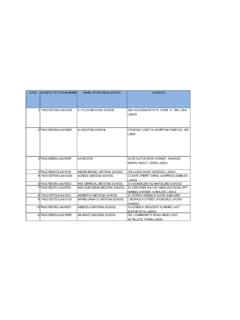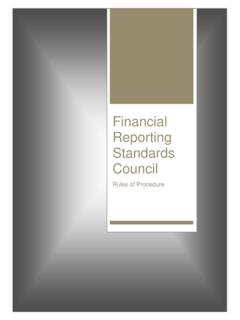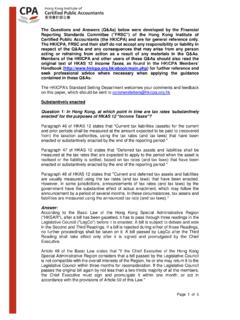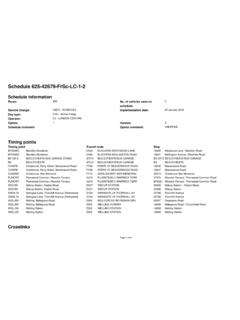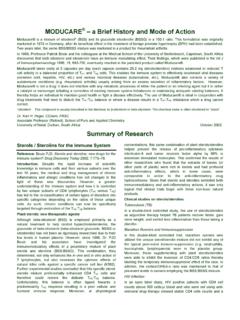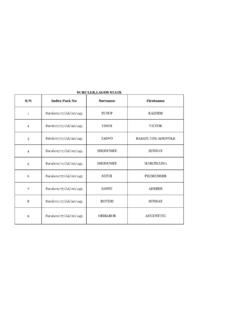Transcription of Developing Analytical Toxicology Services: …
1 Developing Analytical Toxicology services : principles and Guidance RJ Flanagan PhD SRCS CChem FRSC FRCPath Consultant Clinical Scientist Medical Toxicology Unit, Guy s & St Thomas NHS Foundation Trust, London, UK Reviewed by: Dr SB Lall (Poisons Control Centre, Oman), Dr D Tagwireyi (Department of Pharmacy, University of Zimbabwe), Dr A Dewan (National Institute of Occupational Health, India), Dr N Besbelli (International Programme on Chemical Safety, WHO, Geneva). Finalized and published February 2005 A report prepared for the International Programme on Chemical Safety (WHO/ILO/UNEP) Please send comments on this document to: World Health Organization 2005 The mention of specific companies or of certain manufacturers products does not imply that they are endorsed or recommended by the World Health Organization in preference to others of a similar nature that are not mentioned. Errors and omissions excepted, the names of proprietary products are distinguished by initial capital letters.
2 The World Health Organization does not warrant that the information contained in this publication is complete and correct and shall not be liable for any damages incurred as a result of its use. Contents 1. Purpose 3 2. Introduction 3 3. Providing a Clinical Analytical Toxicology Service 3 Regional or National Laboratories? 4 Operation of an Analytical Toxicology Laboratory 5 Analytical Methods 6 Analysis of Pharmaceutical Dosage Forms 7 Training in Analytical Toxicology 7 Analytical Toxicology and the Poisons Centre 8 Reporting Analytical Toxicology Results 8 Research and Development 8 Further Information 8 4. Current Topics in Analytical Toxicology 9 Acetylcholinesterase and Cholinesterase 9 Chemical Incidents 9 Chlorinated Pesticides 10 Drugs of Abuse 10 General Toxicology Screen ( Drug Screen , Poison Screen ) 11 Herbal/Ethnic Remedies 12 Lead 13 Paracetamol (Acetaminophen, N-acetyl-para-aminophenol) 13 Paraquat (1,1 -Dimethyl-4,4 -bipyridylium ion) 15 Solvents and other Volatile Substances 16 Toxic Alcohols (Ethylene Glycol, Methanol) 17 5.
3 Conclusions 17 6. References 19 7. Bibliography 23 Annex 1 25 Table 1. Some emergency toxicological analyses that may influence treatment of poisoning 25 Table 2. Some laboratory investigations that may be needed urgently in the management of poisoned patients 26 Table 3. Some less urgent toxicological analyses that may influence treatment of poisoning 27 Annex 2 28 Proposed national reporting format for surveying of Analytical laboratory facilities for the sound management of chemicals 28 1. Purpose The purpose of this document is to discuss some of the issues that must be considered when trying to establish or refine a clinical Analytical Toxicology service in a country. 2. Introduction Analytical Toxicology is the detection, identification and often also the measurement of drugs and other foreign compounds (xenobiotics) in biological and related specimens to help in the diagnosis, treatment, prognosis, and prevention of poisoning. Analytical Toxicology is important since it is the only means by which objective evidence of the nature and magnitude of exposure to a particular compound or group of compounds can be obtained (Flanagan, 2003).
4 Most obviously such objective evidence is needed in a court of law, and most if not all countries have established Analytical Toxicology facilities as part of governmental forensic science laboratories. Acute poisoning is a common reason for presentation to hospital and most poisoned patients make a full recovery without specific treatment. However, with some common poisons Analytical Toxicology data can be important in establishing a diagnosis of poisoning and guiding treatment. Examples include iron, lithium, and paracetamol (acetaminophen) - see Table 1. The availability of reliable Analytical facilities can also assist in other clinical areas such as assessing illicit drug use and the diagnosis and treatment of poisoning with environmental toxins such as lead, as well as in the management of incidents related to the accidental or deliberate release of chemicals into the environment (chemical incidents) and other aspects of chemical safety. An essential preliminary to the task of establishing an Analytical Toxicology service is to undertake a detailed survey of the perceived toxicological problems encountered in the region or country.
5 These problems may be clinical (not only acute poisoning, but also adverse effects of medication and substance abuse), forensic, and/or occupational/environmental. The survey could be performed by a national or regional poisons centre, but studies of poisoned patients presenting to accident and emergency departments and fatal poisoning data derived from national mortality statistics may also provide valuable information. A further useful preliminary is to undertake a survey of existing facilities for chemical analysis. A questionnaire to assist in this process is available (UNITAR, 2001 - see Annex 2). This is important since infrastructure to support (i) instrumentation such as maintenance, spare parts, and day-to-day consumables, (ii) provision of pure reagents and reference materials, (iii) staff education, training, and development, and (iv) laboratory certification/accreditation is required to ensure the proper establishment and viability of the Analytical Toxicology service.
6 3. Providing a Clinical Analytical Toxicology Service Many acutely poisoned patients are treated with no laboratory help other than general clinical chemistry (blood glucose, blood gases, etc.) and haematology (Flanagan et al., 1995; see Table 2). This being said, emergency toxicological analyses (24 hour availability) that could influence immediate patient management (Table 1) should be provided at regional hospitals, those with large accident and emergency departments. It is important that clinicians and laboratories understand the circumstances under which an emergency analysis can help guide patient treatment and that clear lines of communication between clinicians and laboratories are established in order to maximize the value of the Analytical service. Health Centres and other primary care facilities, centres without accident and emergency departments, that could have occasion to treat poisoned patients should know Page 4 how to access the laboratory services available at district hospitals.
7 Information is available on the management of poisoning in such settings (Henry & Wiseman, 1997). In general the toxicological problems that can be mitigated by emergency laboratory help (Table 1) are remarkably similar worldwide. In part, this is because many poisons, for example carbon monoxide, illicit drugs, and paracetamol (acetaminophen) occur worldwide, and a range of assays to help in management, that do not require complex, expensive equipment, has been developed. More complex, less frequently needed clinical toxicological assays that can often be offered on a less urgent basis (Table 3) are often provided from regional or national centres because of the need to make best use of resources. Recommendations as to the assays that should be provided locally and at regional centres have been published recently from the UK (NPIS/ACB, 2002) and US (Wu et al., 2003) and are generally applicable. Regional or National Laboratories? The decision on how to organize regional Analytical Toxicology services is complex and is based upon many factors including the pattern of poisoning, the distribution of poisoning treatment services , the geography of the area, and requirements for additional assays such as drugs of abuse screening or blood lead analyses.
8 Be this as it may, there must be clear lines of communication with hospitals offering basic Analytical Toxicology facilities to facilitate rapid onward transfer of specimens and reporting of results as appropriate. One especial problem often identified is that of paying for tests on samples sent from a patient at another hospital, and a mechanism to address this situation is obviously needed. Regional Analytical Toxicology laboratories are often situated next to, or are part of, existing clinical chemistry departments in hospitals with accident and emergency and/or intensive care facilities. The advantages of placing the laboratory within an existing clinical laboratory are that many of the facilities and procedures necessary for the proper operation of the laboratory will already be in place or could be easily adapted for this purpose. For example, staff experienced in the health and safety aspects of handling biological samples, in infection control, and the operation of clinical laboratories in general will be on hand and written procedures describing all aspects of laboratory operation will be in place.
9 A nucleus of experienced staff to assist with implementation of an out-of-hours ( emergency) service will also be on hand. As an alternative to establishing a regional laboratory at a hospital, consolidation of an existing occupational/environmental Toxicology or Analytical Toxicology laboratory associated, for example, with a poisons centre could be considered. However, Developing additional facilities and extending the repertoire of tests available on an emergency basis may be more difficult than if the regional/national laboratory were developed in conjunction with an existing hospital. Turnaround time for the tests offered will be important, but clearly turnaround must take into account transport considerations as well as the availability of trained staff to cover a full emergency service. It is important that the activities of regional Analytical laboratories, whilst under local management, should be overseen by a Management Board to coordinate operation of the laboratories with stakeholders within the host organization and outside.
10 These stakeholders should include clinical representatives ( from accident and emergency departments and intensive care units) from the host or other local hospital(s), poisons centre representatives, and a drug-information pharmacist, as well as representatives from the host laboratories. It is important that budgetary and management aspects (catchment area, repertoire of tests, methods used, staffing) of the operation of the laboratory should be under the direction of this committee. Page 5 Because of the specialized nature of Analytical Toxicology investigations it is important that the regional laboratory achieves a critical mass in terms of workload and thus funding. In order to help ensure the viability of these laboratories the development of facilities for drugs of abuse testing, specialized therapeutic drug monitoring, metals analysis, and possibly other assays should be considered. This will not only serve to extend the repertoire of tests available for clinical Toxicology , but also ensure that the laboratories are seen to be contributing to patient care in these other areas.










